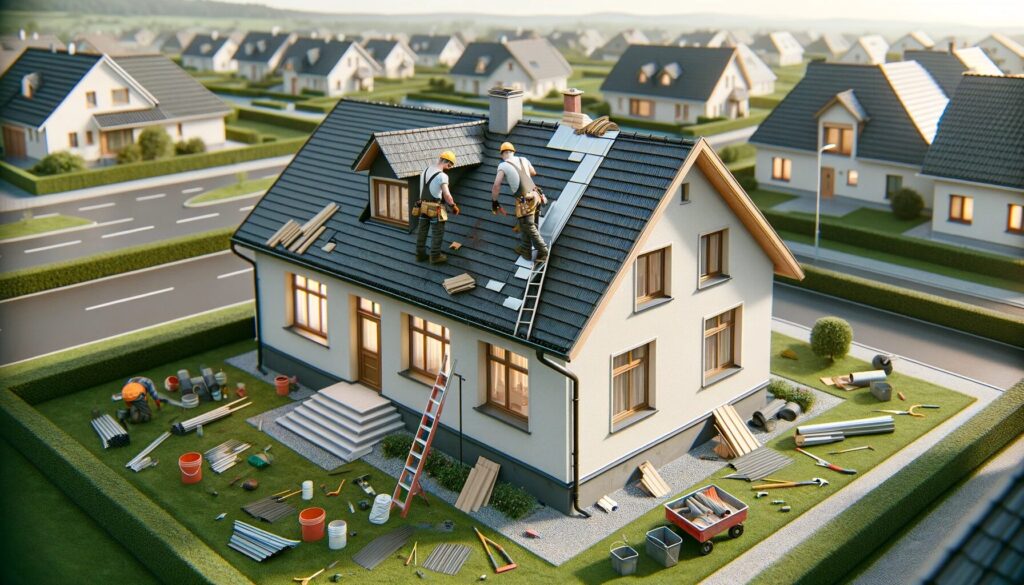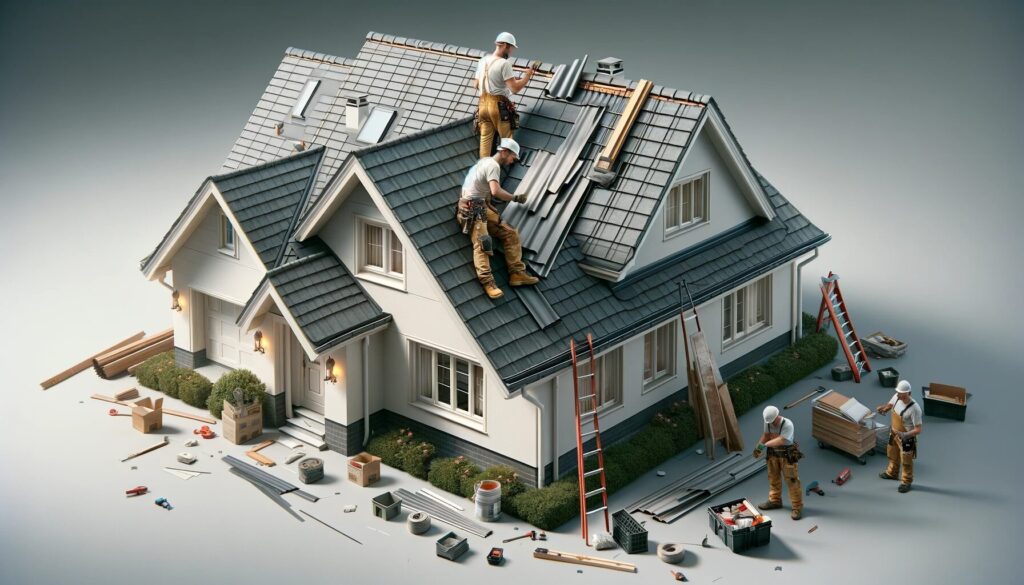In the world of home construction, metal roofs are a standout choice for their longevity and resilience. They’re the go-to for a roof that can withstand the test of time and elements. But, like all things, they’re not immune to wear and tear. Common issues like leaks, rust, and damage from environmental factors are what homeowners with metal roofs often grapple with. Recognizing these issues early and understanding their implications is key to maintaining the roof’s integrity and functionality.

Understanding Metal Roofs
Types and Characteristics
Let’s dive into the different types of metal roofs:
- Standing Seam: These are the modern marvels in metal roofing. Their continuous panels run from the ridge of the roof all the way down to the eaves. The seams between panels are raised, giving it a sleek, streamlined look and an edge in preventing leaks.
- Metal Shingles: Ideal for those who want the classic look with enhanced durability. These mimic traditional shingles but are made of metal, offering a unique blend of aesthetic appeal and long-lasting resilience.
- Corrugated Metal: This type offers a distinct appearance with its rippled metal sheets. It’s not just about looks, these roofs are known for their strength and durability.
Benefits
Opting for a metal roof is an investment in your home’s future. These roofs are champions of longevity, often outlasting traditional materials by decades. They are also energy-efficient, reflecting solar heat and helping to reduce cooling costs. Plus, their resistance to fire, rot, and pests makes them an all-around winner.
Signs of Wear
Being vigilant about roof maintenance can save you from hefty repair bills down the line. Keep an eye out for these telltale signs:
- Leaks: Often found at seams, around fasteners, or at flashing points.
- Rust and Corrosion: Check for any discoloration or weakening of the metal, especially in areas where water accumulates.
- Dents and Damage: Look for any impact damage, particularly after extreme weather events.
Preparing for Metal Roof Repair
Safety First
Safety is paramount. Always wear a safety harness on steep roofs, along with gloves and eye protection. And don’t underestimate the importance of sturdy, non-slip footwear.
Assessing the Damage
Before diving into repairs, assess the extent of damage. Is it a small, manageable leak, or are we looking at widespread rusting? Sometimes what seems minor can be indicative of a larger issue, so a thorough inspection is crucial.
DIY or Pro?
Deciding whether to tackle the repair yourself or call in professionals depends on the scale and complexity of the job. Small leaks or minor dents can often be handled DIY-style. However, if you’re facing extensive damage or structural issues, it’s wise to seek professional help. Remember, quality repair work not only fixes the immediate problem but also preserves the longevity of your roof.

Step-by-Step Guide to Metal Roof Repair
Cleaning the Roof Surface
A clean roof is your starting point. Begin by removing all debris, leaves, and dirt. Use a leaf blower for loose materials, and for tougher grime, opt for a soft bristle brush or a low-pressure washer. Remember, the goal is to clean, not damage, so be gentle with your approach.
Identifying and Addressing Leaks
Locating leaks can be tricky, but focus on common problem areas like seams, fasteners, and around flashings. Once you’ve pinpointed the leak, apply a high-grade urethane or silicone sealant. Apply it evenly and generously, ensuring that you cover the entire problem area for a watertight seal.
Repairing Rust and Corrosion
Early detection of rust can save a lot of trouble. Using a wire brush, gently remove any rust. Then, apply a rust-inhibiting primer, followed by a coat of paint that matches your roof. This not only stops rust from spreading but also restores the aesthetic appeal of your roof.
Replacing Damaged Panels or Shingles
When replacing panels or shingles, it’s like conducting a well-orchestrated swap. Remove the damaged piece carefully, ensuring not to disturb the surrounding area. Fit in the new panel or shingle, securing it with fasteners. The fit should be seamless and snug.
Sealing and Finishing Touches
After repairs, reseal any treated areas. Use a quality acrylic or silicone sealant to protect your work from the elements. This step ensures longevity and durability, safeguarding your repairs against future wear.

Preventative Maintenance for Metal Roofs
Regular Inspection Tips
Routine inspections are key. Conduct them biannually, preferably in spring and autumn, to catch any potential issues early. Pay special attention after extreme weather events.
Cleaning and Maintenance Best Practices
Keep your roof clean with regular washing. Avoid harsh chemicals or abrasive tools, a mild detergent and a soft brush are usually sufficient. This not only maintains the appearance of your roof but also prevents the buildup of harmful materials that can lead to corrosion.
Protective Coatings and Treatments
Applying a protective coating every few years is like giving your roof an extra layer of armor. These coatings protect against UV rays, rust, and other environmental hazards. Choose a coating specifically designed for metal roofs for best results.
Cost Considerations
Estimating Repair Costs
When it comes to estimating the costs for metal roof repair, it’s a bit like putting together a puzzle. Every piece – material costs, the extent of damage, and even regional labor charges – plays a part. Start by evaluating the damage. Minor issues like sealing a leak or replacing a few fasteners can be relatively inexpensive. But if you’re looking at replacing panels or dealing with structural damage, the costs will climb. Don’t forget to factor in the price of any tools or equipment you might need if you’re going DIY.
DIY vs Professional Repair Costs
Deciding between DIY and hiring a professional is a balance of skill, time, and budget. If you have the know-how and the tools, DIY can be cost-effective for minor repairs. But remember, the value of professional work isn’t just in the labor but also in the expertise and warranty that comes with it. In cases where the repairs are complex or beyond your skill level, investing in professional services can actually save money in the long term by ensuring the job is done right the first time.
Long-term Savings and Benefits of Metal Roofs
While the upfront cost of a metal roof may be higher compared to other materials, the long-term savings are significant. Metal roofs have a lifespan that can easily exceed 50 years with proper maintenance, far outstripping the longevity of traditional roofing materials. They’re also more energy-efficient, reflecting sunlight and helping reduce cooling costs during hot months. Additionally, their durability means less frequent repairs and replacements, leading to substantial savings over time.

FAQ Section
Regular inspections are key. Look for telltale signs such as leaks, visible rust, dents, or panels that seem out of place. Catching these issues early can prevent more significant problems down the road.
For minor repairs, like sealing a small leak or touching up a patch of rust, a DIY approach can be effective. However, for more extensive damage, it’s wise to consult a professional to ensure the job is done safely and correctly.
A good rule of thumb is to inspect your roof at least twice a year – typically in the spring and fall. Additionally, it’s prudent to check after any severe weather events that could have caused damage.
Common issues include leaks, especially at seams and around fasteners, corrosion and rust, and impact damage from severe weather conditions.
Yes, applying specialized protective coatings can significantly extend the life of your metal roof. These coatings help shield the roof from elements like UV rays and moisture, and they can also improve energy efficiency. Regular application every few years can be a wise investment in your roof’s longevity.
